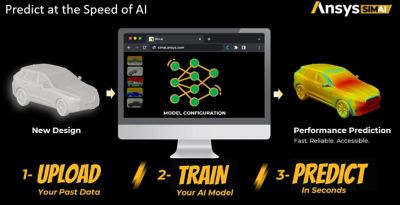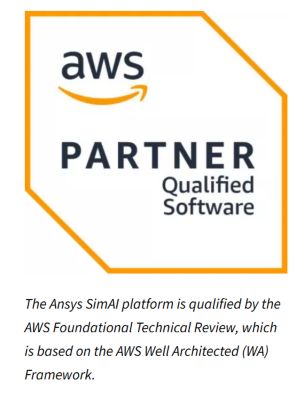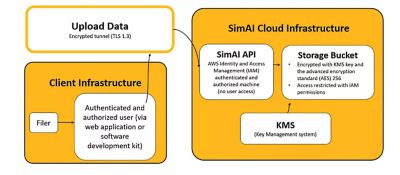-
-
Access Free Student Software
Ansys empowers the next generation of engineers
Students get free access to world-class simulation software.
-
Connect with Ansys Now!
Design your future
Connect with Ansys to explore how simulation can power your next breakthrough.
Countries & Regions
Free Trials
Products & Services
Learn
About
Back
Products & Services
Back
Learn
Ansys empowers the next generation of engineers
Students get free access to world-class simulation software.
Back
About
Design your future
Connect with Ansys to explore how simulation can power your next breakthrough.
Free Trials

Adopting a software-as-a-service (SaaS) solution like the Ansys SimAI cloud-enabled artificial intelligence platform allows engineering teams to offload simulation workloads to the cloud, reducing full-time employee costs and implementation time. This shift accelerates simulation cycles, increases throughput, and enables more designers to access high-performance tools. It also improves the training-to-prediction ratio, optimizing both project timelines and resource allocation.

The Ansys SimAI platform is available via web browser as an SaaS solution.
The Benefits of SaaS for Ansys SimAI
What does software-as-a-service really mean? Is it well suited to any kind of business? Let’s deep dive into why SaaS should be considered over other deployment options, like on-premise?
1. Efficient Data Handling
AI requires the upload of large amounts of data. For the Ansys SimAI platform, the more relevant simulation data you add, the better the model will be trained to deliver a good prediction score. This means you need to transfer a fair amount of data, which is not always easy with on-premise or small datacenter setups. SaaS platforms, however, are designed to handle large data transfers efficiently, leveraging robust cloud infrastructure to ensure seamless data upload and processing.

A simplified SimAI platform workflow
2. Accessibility for All Users
Once trained, one great benefit of AI is that it can be accessed by both simulation experts and non-experts, such as designers. Having a platform that is accessible via a web browser is a massive gain in time for onboarding new members and quickly scaling up or down. SaaS solutions eliminate the need for complex installations and configurations, making it easier for teams to collaborate and access the AI tools they need from anywhere.
3. Focus on Core Business
SaaS helps businesses focus on their core activities, such as delivering better products and engineering solutions. There's no need to worry about purchasing additional storage space, maintaining the architecture, or working to ensure it's safe from attacks. SaaS providers handle these aspects, allowing businesses to concentrate on innovation and product development.
Data Security Concerns
A common concern with SaaS is data security. How can you feel confident that your data is secure?

1. Trusted Partners
SaaS is used by just about everyone in our daily lives, from bank accounts to medical platforms and e-commerce. What matters most is selecting trusted and recognized partners. Large hyperscale providers like Amazon Web Services (AWS) have robust and strong IT infrastructures. AWS attracts and retains top-tier cybersecurity personnel who work to ensure that their platforms are secure and reliable.

2. Strong Partnerships = Robust Security
We have a strong partnership with AWS to help secure data, create optimized architectures, and guarantee availability and geo-replication.
AWS implements best practices for securing sensitive data, including encryption, identity and access management, and incident response protocols.
Your data is stored in an encrypted data bucket in Amazon Simple Storage Service (S3) and transferred through an encryption tunnel protected by transport layer security (TLS) 1.3 — the most recent and strongest version of the TLS security protocol.
Once your data is uploaded to the SimAI platform, you can configure a model and initiate training with confidence that your data remains secure throughout all stages of the workflow. The architecture performing training and inference is hosted in the AWS Europe region (eu-west-1, Ireland), using the best security practices.
3. Secured Infrastructure
The SimAI platform is multitenant with logical separation through tenant- and user-based ownership. In other words, customers have access only to their own data. In a similar manner, simulations are run on tenant-exclusive, ephemeral-allocated instances and all read objects are copied, used, and then destroyed.
As another layer of security, the SimAI platform infrastructure is managed using an infrastructure as code (IAC) model on Kubernetes (k8s) clusters using Amazon Elastic Kubernetes Service (EKS). What does this mean? Put simply, k8s clusters are groups of nodes that run containerized applications. This enables multiple applications to run securely in a more efficient, scalable way. As a result, the benefits of the IAC model are maximized.
In addition, Ansys’ internal services are secured by a firewall and virtual private network (VPN) while client-accessible web applications and application programming interface (API) endpoints use an industry-grade authentication and authorization service. Accordingly, SimAI platform user accounts are managed through this service, which verifies access to the platform using a customer identity provider (IdP). For example, the platform may delegate authentication to a client’s IdP to ensure that the client controls who has access to the service. Data transfer is possible only after authentication and authorization.
The AI training and inference on Amazon EC2 use the robust foundation provided by the AWS Nitro System. It includes a highly secure hypervisor designed to deliver strong resource isolation and performance that is nearly indistinguishable from a bare metal server. Postprocessing tasks on Amazon EC2 also benefit from the enhanced security and efficiency of the Nitro System, ensuring that data integrity and processing speeds meet the rigorous demands of modern AI applications. For more information on the AWS Nitro System, refer to the AWS white paper The Security Design of the AWS Nitro System.
Also, your storage — that is, your Amazon S3 data bucket — is protected with AWS Key Management Service (KMS) encryption owned only by ephemeral compute instances, which use the advanced encryption standard (AES) 256. AES-256 is considered the strongest encryption method available, requiring a 256-bit key. Additionally, access is filtered and restricted by AWS Identity and Access Management (IAM) permissions, including guardrails and access controls.

The SimAI infrastructure
Join Our Webinar To Learn More
Join our webinar June 19 to learn more about the SimAI platform and the security benefits for SaaS. We'll dive deep into how we ensure that our solution is best-in-class for security and IT deployment.
The Advantage Blog
The Ansys Advantage blog, featuring contributions from Ansys and other technology experts, keeps you updated on how Ansys simulation is powering innovation that drives human advancement.


